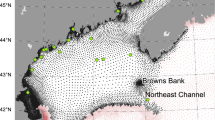Abstract
THE Greenland Sea is particularly important to the world ocean circulation, and potentially to carbon dioxide exchange between the ocean and atmosphere, because it is an area of surface convergence and deep-water formation1–3. Previous investigations indicate that biological productivity is low4,5 in this area, especially in waters remote from the ice edge. During April and early May 1989, however, we observed the development of a massive bloom of the colonial prymnesiophyte Phaeocystis pouchetii across much of the Greenland Sea. From measurements of the rate of removal of nitrate from surface waters, we calculate that the average regional new production was about 40 g C m−2 during the 35-day period of our observations. This rate of new production is approximately equal to that observed in other hyperproductive polar regions, such as the Bering Sea and the Bransfield Strait. Because Phaeocystis blooms seem to be frequent and widespread in polar oceans4,6, our results suggest that the Greenland Sea may be a larger sink of atmospheric carbon dioxide than has been previously thought.
Similar content being viewed by others
References
Peng, T.-H., Takahashi, T. & Broecker, W. S. Tellus 39, 439–458 (1987).
Anderson, L. G. & Jones, E. P. J. mar. Systems (in the press).
Takahashi, T. et al. J. Rit. Fiskideild. 9, 20–36 (1985).
Baumann, M. E. M. thesis, Univ. of Aachen (1990).
Smith, W. O. Jr & Sakshaug, E. in Polar Oceanography, Part B (ed. Smith, W. O. Jr) 477–525 (Academic, San Diego, 1991).
Wassmann, P., Vernet, M., Mitchell, B. G. & Rey, F. Mar. Ecol. Prog. Ser. 66, 183–195 (1990).
Paquette, R. G., Bourke, R. H., Newton, J. F. & Perdue, W. F. J. geophys. Res. 90, 4866–4882 (1985).
Smith, W. O. Jr, Baumann, M. E. M., Wilson, D. L. & Aletsee, L. J. geophys. Res. 92, 6777–6786 (1987).
Keene, N. K., Smith, W. O. Jr & Kattner, G. Polar Biol. (in the press).
Codispoti, L. A., Friederich, G. E., Sakamoto, C. M. & Gordon, L. I. J. mar. Systems (in the press).
Jones, E. P., Nelson, D. M. & Treguer, P. in Polar Oceanography, Part B (ed. Smith, W. O. Jr) 407–476 (Academic, San Diego, 1990).
Clarke, R. A. Deep-Sea Res. 37, 1383–1411 (1990).
Sverdrup, H. U. J. Cons. Explor. Mer 18, 287 (1953).
Eppley, R. W. & Peterson, B. J. Nature 282, 677–680 (1979).
Redfield, A. C. Am. Scient. 46, 205–221 (1958).
Cota, G. F., Smith, W. O. Jr & Mitchell, B. G. Eos 71, 79 (1990).
Smith, W. O. Jr & Harrison, W. G. Deep-Sea Res. (in the press).
Gunkel, J. thesis, Univ. of Kiel (1988).
Stefánsson, U. & Ólafsson, J. J. Rit Fiskideild. (in the press).
Bodungen, B. V., Bauerfeind, E., Koeve, W. & Zeitzschel, B. Eos 71, 65–66 (1990).
Hebbeln, D. & Wefer, G. Nature 350, 409–411 (1991).
Estep, K. W., Nejstgaard, J. C., Skjoldal, H. R. & Rey, F. Mar. Ecol. Prog. Ser. 67, 235–249 (1990).
Smith, W. O. Jr & Nelson, D. M. Limnol. Oceanogr. 35, 809–821 (1990).
Karl, D. M., Tilbrook, B. D. & Tien, G. Deep-Sea Res. (in the press).
Walsh, J. J. et al. Prog Oceanogr. 22, 277–359 (1989).
Smith, S. L., Smith, W. O. Jr, Codispoti, L. A. & Wilson, D. L. J. mar. Res. 43, 693–707 (1985).
Tans, P. P., Fung, I. Y. & Takahashi, T. Science 247, 1431–1438 (1990).
Keeling, C. D. et al. in Aspects of Climate Variability in the Pacific and the Western Americas (ed. Peterson, D.) 165–363 (American Geophysical Union, Washington DC, 1989).
Watson, A. J., Robinson, C., Robinson, J. E., Williams, P. J. le B. & Fasham, M. J. R. Nature 350, 50–53 (1991).
Author information
Authors and Affiliations
Rights and permissions
About this article
Cite this article
Smith, W., Codispoti, L., Nelson, D. et al. Importance of Phaeocystis blooms in the high-latitude ocean carbon cycle. Nature 352, 514–516 (1991). https://doi.org/10.1038/352514a0
Received:
Accepted:
Issue Date:
DOI: https://doi.org/10.1038/352514a0
- Springer Nature Limited
This article is cited by
-
Effect of dissolved iron (II) and temperature on growth of the Southern Ocean phytoplankton species Fragilariopsis cylindrus and Phaeocystis antarctica
Polar Biology (2023)
-
Differences Between Solitary Cells and Colonial Cells in the Heteromorphic Life Cycle of Phaeocystis globosa: Morphology, Physiology, and Transcriptome
Journal of Ocean University of China (2021)
-
Phytoplankton dynamics in a changing Arctic Ocean
Nature Climate Change (2020)
-
Variability of Winter-Spring Bloom Phaeocystis pouchetii Abundance in Massachusetts Bay
Estuaries and Coasts (2016)
-
Key Arctic phototrophs are widespread in the polar night
Polar Biology (2015)





